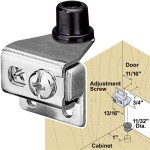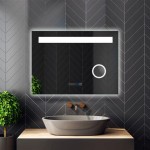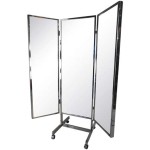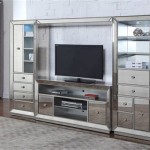What Hardware Do I Need to Hang a Heavy Mirror?
Hanging a heavy mirror is a common task for homeowners and interior designers. However, it requires careful planning and the use of appropriate hardware to ensure the mirror is securely mounted and remains safely in place. Selecting the correct hardware depends on several factors, including the weight of the mirror, the type of wall it will be hung on, and the desired aesthetic. Utilizing inadequate or inappropriate hardware can lead to the mirror falling, potentially causing damage to the mirror, the wall, and anyone nearby. This article outlines the essential hardware and considerations involved in hanging a heavy mirror safely and effectively.
Determining the Weight of the Mirror and Wall Type
Before purchasing any hardware, the initial step involves accurately determining the weight of the mirror. This information is crucial for selecting hardware with an adequate weight rating. The weight can usually be found on the mirror's packaging or by contacting the manufacturer. If the weight is unknown, using a bathroom scale is a practical solution. Weighing oneself and then weighing oneself while holding the mirror allows for the calculation of the mirror's weight via subtraction.
The type of wall the mirror will be hung on is equally important as it dictates the appropriate anchoring methods. Common wall types include drywall, plaster, wood studs, and masonry (brick or concrete). Each wall type requires different types of anchors to provide the necessary support. Neglecting to identify the wall type can lead to using inappropriate anchors, resulting in failure and potential damage.
Drywall, a common wall material, is relatively weak and cannot support significant weight on its own. Plaster, while generally stronger than drywall, can be brittle and prone to cracking if not handled carefully. Wood studs offer the most secure attachment point, as they are solid and can bear significant weight. Masonry walls, such as brick or concrete, are extremely strong but require specialized anchors and drilling techniques.
Essential Hardware Components for Hanging Heavy Mirrors
The hardware required for hanging a heavy mirror generally includes wall anchors, screws, hanging wire or D-rings, and picture hooks or hanging brackets. The specific type of each component required depends on the weight of the mirror and the wall type.
Wall Anchors: These are designed to distribute the weight of the mirror over a larger surface area on the wall, providing a secure hold. For drywall, several types of anchors are available, including:
- Molly bolts: These anchors expand behind the drywall when tightened, providing a strong and reliable hold. They are suitable for moderate to heavy mirrors.
- Toggle bolts: These anchors feature wings that fold out behind the drywall, providing a very strong hold. They are ideal for heavier mirrors.
- Self-drilling drywall anchors: These anchors are easy to install and suitable for lighter mirrors. They are not recommended for very heavy items.
Screws: The screws used in conjunction with wall anchors must be of the correct length and gauge. The length should be sufficient to pass through the mirror's hanging hardware, the wall anchor, and penetrate deep enough into the wall for a secure hold. The gauge refers to the thickness of the screw; thicker screws provide more strength. It is recommended to use screws that are specifically designed for use with the chosen wall anchors.
Hanging Wire or D-Rings: The method of attaching the mirror to the wall also influences the hardware needed. Many mirrors come with D-rings already attached to the back. If the mirror does not have D-rings, they must be installed. D-rings are small metal loops that attach to the back of the mirror frame and allow for hanging. For heavier mirrors, using two D-rings is preferable to distribute the weight evenly. Hanging wire, typically made of braided steel, is used to connect the D-rings. The wire's weight rating must exceed the weight of the mirror. Alternatively, some mirrors are designed to be hung directly on brackets or cleats. In this case, no wire or D-rings are necessary, but the brackets or cleats must be securely attached to the wall and rated to support the mirror's weight.
Picture Hooks or Hanging Brackets: These attach to the wall and provide a point for the mirror to hang from. For lighter mirrors, standard picture hooks are often sufficient, provided they are rated for the mirror's weight. For heavier mirrors, heavy-duty picture hooks or hanging brackets are necessary. French cleats are a popular option for hanging heavy mirrors. These consist of two interlocking pieces: one attached to the wall and the other attached to the back of the mirror. The interlocking design provides a very secure and stable hold.
Selecting the Right Hardware Based on Weight and Wall Type
The selection of appropriate hardware requires careful consideration of both the mirror's weight and the wall type. A systematic approach helps ensure safety and stability.
Mirrors Weighing Up to 20 Pounds: For mirrors in this weight range hung on drywall, self-drilling drywall anchors or small plastic anchors may be sufficient. However, it is crucial to verify that the anchors are rated to hold at least the mirror's weight. Finding a stud is ideal, in which case screws driven directly into the stud provide the most secure attachment. For plaster walls, small plaster anchors or screws driven into a stud are suitable.
Mirrors Weighing Between 20 and 50 Pounds: For this weight range hung on drywall, molly bolts or toggle bolts are recommended. These anchors provide a significantly stronger hold than self-drilling or plastic anchors. Again, locating and utilizing a stud is preferred. For plaster walls, heavy-duty plaster anchors are necessary if a stud cannot be located. Ensure the anchors are rated to support the mirror's weight. For masonry walls, concrete screws or small masonry anchors are required.
Mirrors Weighing Over 50 Pounds: Hanging mirrors of this weight requires a robust approach. For drywall, toggle bolts are the best option, providing a very strong and secure hold. Finding at least one stud to secure the mirror to is strongly recommended. French cleats are also an excellent choice for heavy mirrors. For plaster walls, it is essential to locate and utilize studs whenever possible. If studs are not accessible, use heavy-duty plaster anchors designed for significant weight. For masonry walls, heavy-duty masonry anchors are required, and professional installation is often recommended.
Regardless of the mirror's weight or wall type, over-engineering the hanging system is always preferable. Using hardware with a higher weight rating than necessary provides an extra margin of safety and peace of mind. Regularly inspecting the hanging hardware is also crucial to ensure it remains secure and in good condition. If any signs of looseness or damage are detected, the hardware should be replaced immediately.
In summary, safely hanging a heavy mirror involves accurately determining the mirror's weight, identifying the wall type, and selecting appropriate hardware with an adequate weight rating. Using the correct anchors, screws, hanging wire or D-rings, and picture hooks or hanging brackets is essential for a secure and stable installation. When in doubt, consulting with a professional installer is recommended to ensure the mirror is hung safely and effectively.
How To Hang A 100 Pound Mirror On Drywall Quora

How To Hang A Heavy Mirror C R F T

How To Hang A Large Or Heavy Mirror

How To Hang A Heavy Mirror The Home Depot

How To Hang A Heavy Mirror The Home Depot

How To Hang A Heavy Mirror

How To Hang A Heavy Mirror

How To Hang A Heavy Mirror With Pictures Wikihow

How To Hang A Heavy Mirror The Home Depot

How To Hang A Heavy Mirror With Pictures Wikihow








